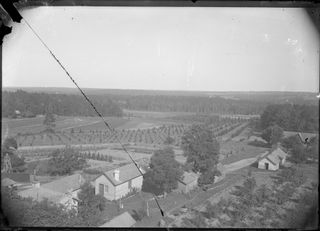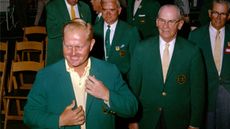The Flora At Augusta National Golf Club
The flora at Augusta National is one of the aspects that make this course so special, and such a visual delight to television audiences worldwide


The Flora At Augusta National
The flora at Augusta National adds to the spectacle of the Masters tournament. It also harks back to this plot of land’s former usage as a plant nursery.
When Bobby Jones and Clifford Roberts were looking for somewhere to build their golf course, a mutual friend suggested the 365 acres formerly owned by Fruitland Nurseries. This land had already been bought by a hotel company but, unable to afford to build their intended hotel due to finances, the company was looking to sell the property.

An overhead shot of the nursery
This land had been an indigo plantation which was purchased in 1857 by Louis Mathieu Edouard Berckmans, whose hobby was horticulture. Berckmans’ son, Prosper Julius Alphonso, was a professional horticulturist. Father and son set up Fruitland Nurseries, which imported many trees and plants.
A great variety of flowering plants and trees, including a long row of magnolias, which were planted before the Civil War, and azalea, a plant Prosper popularized, remained on the land.
Both of these have become famous parts of the Augusta National landscape. All the holes at Augusta are named after flowers and shrubs and the 13th hole at Augusta National is called Azalea, and on this hole are about 1,600 azaleas. Around the course are about 30 different varieties of azalea. The row of magnolia line Magnolia Lane, the entrance to the club. Magnolia is also the name of the 5th hole at Augusta.

Magnolia Lane
But much of the planting has been by Augusta National itself. When the course was being constructed, Jones and Roberts invited Prosper Berckmans’ son Louis, by now 74 years old, to advise on plantings.
Get the Golf Monthly Newsletter
Subscribe to the Golf Monthly newsletter to stay up to date with all the latest tour news, equipment news, reviews, head-to-heads and buyer’s guides from our team of experienced experts.
Jones and Roberts asked Henry Parsons Crowell, founder of the Quaker Oats Company, to help him in this task. Cromwell had a home in Augusta and was a keen gardener and was appointed Chairman of the Beautification Committee.
Crowell and Berckmans arranged for the planting of more than 4,000 plants and trees in the spring of 1932. Each hole was to have its own distinct flora, and this was to be reflected in the hole name as all holes at Augusta are named after the flora on them,.

Some of the hole names have changed over time. For example the 12th at Augusta National was originally called Three Pines, after the trio of pine trees by the tee. But the pines all died, so the 12th was called Golden Bell instead, after the deciduous flowering shrub behind the green.
The club estimates that since the course was built, more than 80,000 plants of over 350 varieties have been added on Augusta National’s property. Many of the flowers selected are ones which will be in bloom around the first full week of April, the date of the Masters.
Contributing Writer Golf courses and travel are Roderick’s particular interests and he was contributing editor for the first few years of the Golf Monthly Travel Supplement. He writes travel articles and general features for the magazine, travel supplement and website. He also compiles the magazine's crossword. He is a member of Trevose Golf & Country Club and has played golf in around two dozen countries. Cricket is his other main sporting love. He is the author of five books, four of which are still in print: The Novel Life of PG Wodehouse; The Don: Beyond Boundaries; Wally Hammond: Gentleman & Player and England’s Greatest Post-War All Rounder.
-
 'Gator Netting Is In Place' - Chevron Championship Venue Prepared For 'Safe' Winner's Jump
'Gator Netting Is In Place' - Chevron Championship Venue Prepared For 'Safe' Winner's JumpA tradition which began at the tournament's previous home could continue this year - if the champion is feeling brave enough...
By Jonny Leighfield Published
-
 New Balance 997 SL Golf Shoe Review
New Balance 997 SL Golf Shoe ReviewNew Balance produce some extremely stylish footwear and, in this review, Matt Cradock takes their spikeless 997 SL onto the course
By Matt Cradock Published
-
 Why Tiger Woods’ Masters Week Was Actually A Huge Success
Why Tiger Woods’ Masters Week Was Actually A Huge SuccessWoods finished last at an event in which he made the cut for just the third time in his near-30-year pro career at The 2024 Masters - but looking at the result here is too short-sighted...
By Jonny Leighfield Published
-
 What Golf Shoe Does Bryson Dechambeau Wear?
What Golf Shoe Does Bryson Dechambeau Wear?DeChambeau has worn many pairs of golf shoes throughout his career, with the American currently wearing the FootJoy HyperFlex Carbon
By Matt Cradock Published
-
 The Masters Azalea Cocktail Recipe: How To Make The Famous Augusta National Drink
The Masters Azalea Cocktail Recipe: How To Make The Famous Augusta National DrinkThanks to the Masters’ official pinterest page, we now know how to make the famous cocktail the right way
By Joel Kulasingham Published
-
 The 2018 Fairway Wood Tiger Woods Is Using At The Masters
The 2018 Fairway Wood Tiger Woods Is Using At The MastersDespite being an older model, the 15-time Major winner has kept the TaylorMade M3 fairway wood in his bag for over six years and continues to use it at Augusta National
By Matt Cradock Published
-
 What Golf Shoes Is Camilo Villegas Wearing At The Masters?
What Golf Shoes Is Camilo Villegas Wearing At The Masters?The multiple-time PGA Tour winner was seen wearing a pair of eye-catching Nike Air Jordan shoes whilst paired with Rory McIlroy during the third round at Augusta National
By Matt Cradock Published
-
 Who Has Won The Most Money At The Masters?
Who Has Won The Most Money At The Masters?Jack Nicklaus has won the most Green Jackets in history and Tiger Woods is the most successful champion in the modern era - but the answer is neither of those two...
By Jonny Leighfield Published
-
 Who Has Made The Most Consecutive Cuts At The Masters?
Who Has Made The Most Consecutive Cuts At The Masters?Tiger Woods is chasing a record-breaking 25th consecutive cut at the 2024 Masters
By Joel Kulasingham Published
-
 Who Gives The Green Jacket If There's A Back-To-Back Winner Of The Masters?
Who Gives The Green Jacket If There's A Back-To-Back Winner Of The Masters?Traditionally, the previous winner of The Masters hands the new champion the Green Jacket - here's what happens when there's a back-to-back winner
By Mike Hall Published